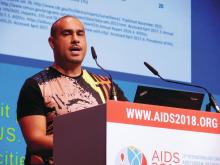AMSTERDAM – The U.S. HIV epidemic during this decade has shown an overall slow but steady decline, with national incidence rates dropping by 5% during 2011-2016. But preventing new HIV infections is clearly falling short for a few, key demographic slices that make up the vast majority of the roughly 40,000 new U.S. HIV cases annually in recent years: black/African American men, Hispanic/Latino men, men who have sex with men (MSM), and young adults aged 25-34 years.
What’s especially glaring in data from the Centers for Disease Control and Prevention are the increasing incidence rates when these groups overlap, compared with falling rates of new HIV infections for most everyone else. The CDC’s numbers for 2010-2015 show statistically significant increases in HIV incidence among MSM aged 25-34 years who are black/African American or Hispanic/Latino. Black/African American MSM accounted for 26% of the total 39,782 U.S. HIV diagnoses in 2016, and Hispanic/Latino MSM accounted for 19%, according to CDC statistics, while all blacks/African Americans accounted for 44% of 2016’s new HIV infections and all Hispanic/Latinos had 25%.
Why are these relatively small demographic subgroups bucking the overall national trend toward fewer infections? Why are their incidence rates so stubbornly high?
A major reason is that the U.S. medical community that delivers HIV prevention, diagnosis, and treatment has fallen short in reaching out to, engaging, and facilitating HIV services to these hardest-hit groups, David Malebranche, MD, said in a plenary talk at the 22nd International AIDS Conference. He cited several factors that contribute to the HIV high-risk populations from getting the care they need.
First, there is HIV stigma, which can be especially acute when accompanied by stigmatization that’s also based on race, ethnicity, and sexual orientation.
“HIV stigma causes difficulties in navigating the HIV treatment cascade. HIV stigma can adversely affect testing behavior, disclosure to sex partners and loved ones, and medical care access,” said Dr. Malebranche, an internal medicine physician and HIV specialist at Morehouse School of Medicine in Atlanta who described himself during his talk as a “ black, same-gender-loving man.” People diagnosed with HIV “will consciously choose to live in a trancelike denial of HIV,” he noted. He also cited criminalization of HIV status as another driver of stigmatization, with 34 states having HIV-specific criminal laws, sentence enhancements, or both.
Beyond HIV status, other stigmas permeate clinics based on race, sex, sexual orientation, immigrant status, and gender identity. A need exists to “study what patients experience in clinics, to identify the barriers to patient engagement and antiretroviral therapy,” but Dr. Malebranche suggested that the HIV medical community is “afraid to evaluate and assess their systems because they’re scared of what they’ll see.” U.S. HIV care has been too focused on scientific advances while “losing sight of the larger social picture,” he maintained.
“The power differential between medical systems and vulnerable communities may be partly responsible for why viral suppressions rates are so low.”
Dr. Malebranche placed much of the blame on the HIV clinical community for failing to engage patients in the most affected demographic groups.
“If a health system or clinic has problems with patient adherence, it needs to self-examine the service it provides. Most research into black MSM and the HIV treatment cascade has looked at what’s wrong in the community first and has only looked at the medical community much later, if at all,” Dr. Malebranche said. “Medical systems say things like ‘they are hard to reach,’ and ‘they don’t trust doctors,’ and ‘they are uneducated.’ Medical systems do this to avoid holding themselves accountable.”
But the people who run these systems often don’t question whether the paperwork is too onerous, certification to receive care is too cumbersome, the location too stigmatizing, and whether the staff is trained in cultural humility. “Blaming the victim doesn’t get us far in public health,” he said. The people who run and staff U.S. HIV programs “should consider the power dynamics created by some of their spaces, employees, and protocols that make them complicit in perpetuating vulnerability, and this may be why patients fall out of care. Don’t call black and same-gender-loving people ‘hard to reach’ just because you don’t know how to reach them,” he said.
In addition to calling for better appreciation of the target populations and better accommodation of their needs, Dr. Malebranche suggested greater use of peer navigators, case managers, social workers, rapid test and treat programs, and attention to overall patient health and not just their HIV status. Fundamentally, he said, the HIV medical community needs to go beyond thinking in terms of just HIV suppression and “practice the art of medicine to keep patients engaged.”
SOURCE: Malebranche D, AIDS 2018, Abstract THPL0107.


